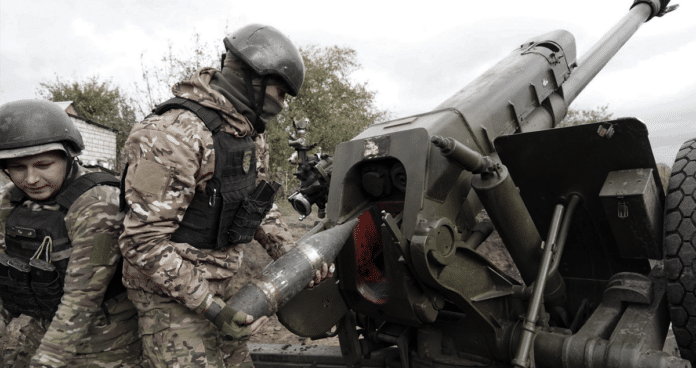Chris Gray, Socialist Alternative (ISA in the United States)
(This article was first published on 10 July 2023)
As inter-imperialist tensions continue to heighten, capitalist governments around the world plan to spend over $6 trillion on their militaries in the next three years. That’s enough to fully fund a global, complete transition away from a fossil fuel-based economy. Capitalist countries around the world spend twice as much on arms today as they did in 1980.
A key feature of the new geopolitical era we’ve entered is the decline of US capitalism as the predominant world power. When mass anti-colonial movements forced out the British in the 1940s, the Indian economy was only 1% of global GDP. Today it’s 10%. In 1960, China made up 2.5% of the world’s GDP. Today it’s 23%.
In this new period, world politics is increasingly defined by the inter-imperialist rivalry between the US and China who are both vying to become, or remain, the primary world superpower. This overarching dynamic in the world situation can be seen in almost every facet of world relations. US sanctions on microchips have all but destroyed the global ambitions of Chinese tech corporations like Huawei. In turn, the Chinese government sanctioned Micron, a US microchips producer, terrifying the CEOs of corporations like Apple because their production process is so intertwined with China.
One of the most important manifestations of this inter-imperialist rivalry is the ongoing war in Ukraine. The people of Ukraine have been absolutely brutalized, their homes destroyed, in a war whose dominant feature is a proxy battle between the US and China. The US, and other NATO forces, have armed the Ukrainian military to the teeth not because they’re concerned with the well-being of the Ukrainian people, but because they hope a defeat for Russia, and the destabilizing of Putin’s reactionary regime, will harm China, Russia’s key ally. On the other side, the prospect of a pro-western regime in Russia – which shares a land border with China longer than the distance between New York and Seattle – is a terrifying prospect for Chinese capitalism.
It is this overarching, unimaginably tense dynamic between the two world superpowers, alongside the long-term decline in global capitalism, that is propelling countries the world over toward increased militarization.
Every capitalist government is preparing for war
To maintain its economic advantages, US capitalism leans on its military power. Other imperialist countries do the same thing, but US imperialism still makes up 40% of all arms spending around the world. Politicians on both sides of the aisle agree maintaining US imperialism is a top priority, as we saw with the debt ceiling debate where the question of cutting military spending didn’t even enter the conversation. However, other governments are also spending far more on weapons of war.
US imperialism has sent $75 billion to Zelensky’s regime in Ukraine. This is more than France’s entire military budget for a year. Only 5% of this is used for humanitarian purposes. For a devastating contrast, it would cost $58 billion a year to make public college free in the US.
NATO is a military alliance that protects capitalism in Europe, and by extension the US. To be a member a country is expected to spend 2% of its GDP on military spending. In 2014, only two NATO countries hit this target. Today seven countries do. NATO is encouraging countries to go further. Poland is spending 4% of its GDP on military spending. This spring, French President Emmanuel Macron called for a shift to a “war economy.” Germany is investing €100 billion into its military, a significant shift from Germany’s post-WWII low levels of military investment, and permanently deploying a brigade in Estonia.
Japan is raising its military budget 60% over the next five years. South Korea is raising its budget 40% over the same period. The US and the Philippines conducted the biggest joint military exercise to date this year. Biden became the first US president to sell a nuclear submarine to a foreign country in 63 years, selling three to Australia earlier this year. India and Pakistan have doubled their military budget over the last ten years. A key goal of Modi’s red-carpet visit to Washington was to secure defense deals from the US, even as the average Indian worker still earns $330 per month.
China has increased its military budget 75% over the last 10 years. The US government claims China is constructing 200 new missile silos, expanding its mobile-launch capability, and upgrading its submarine fleet. It is claimed that Chinese President Xi Jinping has set the target of being capable of invading Taiwan by 2027, though there are doubts about the timeline of this goal. Invading Taiwan would require a war on a scale far bigger than Ukraine and almost certainly mean a direct confrontation with US imperialism.
Killing is cheaper
In May, The Economist coldly explained that military spending today gets “more bang for your buck,” highlighting the real value capitalism puts on human life. Robotics has made modern, imperialist armies cheaper to deploy. Brazil spends 78% of its military budget on soldiers compared with less than 50% in NATO armies. Official US government data shows the price of a missile has fallen 30% since the 1970’s.
Weapons are also more destructive. For example, the price of a fighter jet has remained flat, though one venture capitalist pointed out “These days you can hit dozens of targets with a single bomber, rather than vice versa, which used to be the case,” argues James Geurts, a retired air-force colonel who advises Lux Capital, a venture-capital firm.
The threat of nuclear war
Obama, Trump, and Biden all changed US nuclear policy to open the door to a “first strike,” i.e. launching nuclear weapons first, not just when you are attacked. Putin has revised Soviet-era nuclear doctrine to make it more vague and conditional and has threatened to use nuclear weapons in Ukraine. Both the U.S. and Russia are spending hundreds of millions on smaller tactical nuclear weapons – “first strike” weapons designed to destroy military installations without provoking an all-out catastrophic counterattack.
China is the only nuclear-armed country that formally adheres to a no-first-strike doctrine. However, they recently tested their Fractional Orbital Bombardment System, a weapon system that is only useful as a first-strike weapon. Hypersonic cruise missiles, which are being researched by every major imperialist country, are designed to evade missile defense systems.
These weapons are inherently dangerous because of the logic of nuclear war: if you believe your opponent can knock out your weapons, why not use your weapons first? Nuclear inspectors claim Iran is capable of developing a nuclear weapon in 12 days, if it ramped up its uranium enrichment. The right-wing Netanyahu regime has pledged to attack Iran if it develops nuclear weapons.
The reemergence of conventional weapons
Despite what imperialist countries claim, modern warfare is no less deadly and dehumanizing than before. There have been tens of thousands of casualties in the months-long “meatgrinder” battle for the Ukrainian city of Bakhmut including in human wave attacks. This evokes the battles of the world wars in the 20th century.
The US is increasing production of 155mm artillery shells, a weapon design that has changed little over the last hundred years, to 24,000/month – a sixfold increase since last year. The US is researching new and more deadly landmines. Land mines were “outlawed” in 1997 because they have indiscriminately killed hundreds of thousands of people, often decades after wars end.
In Taiwan, US military advisors are shying away from fancy, “smart” weapons to defend against a Chinese attack. Inspired by the bloodshed in Ukraine, they are shipping machine guns, handheld missiles, and bullets to Taiwan, and training civilian militias for house-to-house guerilla warfare.
We need a socialist alternative
For now, US imperialism is still the main driving force of warfare across the world, and this has been made possible by nearly unanimous consent among both corporate parties. Even self-described “socialists” like Bernie and The Squad have backed imperialism outright, or failed to mount an effective resistance to imperialist militarism by using their position to call for anti-war protests.
This capitulation has opened the door for right-wing populists to pose as anti-war candidates on a nationalist basis, even though the nationalism of a capitalist superpower like the United States always points back towards more imperialism. What is needed is a genuinely socialist, internationalist resistance to imperialism, which fights for the interests of the working class in every country to end war once and for all.




